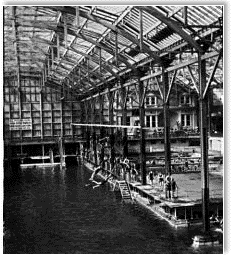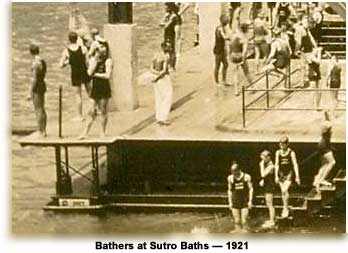“Pacific Service” Supplies the World’s Largest Baths
By J.E. VAN HOOSEAR, Industrial Department
Pacific Gas and Electric Co.
A very recent piece of business secured by the Industrial Department of “Pacific Service” is the light and power load of the famous Sutro Baths in San Francisco which, from the time they opened some seventeen years ago, have been operated independent of any outside power.
 It is necessary to maintain a large boiler installation to heat the water for the tanks, which is changed every day, as well as to furnish hot water and steam for the laundry where the several hundred towels and bathing suits are cleansed. In the beginning an engine and generator were installed to furnish light for the building and a small engine to operate the several machines needed. This was a very good combination, but it had many uneconomical as well as inconvenient features, namely, running of boiler plants when heating and laundry work were finished so as to be ready when lighting load came on, operating the whole plant when only a few lights were needed, and a great many other things too numerous to mention. It is necessary to maintain a large boiler installation to heat the water for the tanks, which is changed every day, as well as to furnish hot water and steam for the laundry where the several hundred towels and bathing suits are cleansed. In the beginning an engine and generator were installed to furnish light for the building and a small engine to operate the several machines needed. This was a very good combination, but it had many uneconomical as well as inconvenient features, namely, running of boiler plants when heating and laundry work were finished so as to be ready when lighting load came on, operating the whole plant when only a few lights were needed, and a great many other things too numerous to mention.
With the central station service now installed all this changed, as it is now possible to use any number of lights from one to the whole number at any time, and also to use all sorts of electrical apparatus, such as electric hair dryers, electric warming pads, sewing machines, and many other electrical devices.
In making this change the entire power and lighting installation was carefully looked over and such changes recommended as would give the consumer the most efficient and up to date system. The lighting of such a structure as this presents a problem that cannot be settled in an off-hand way, but needs the careful study of one who is familiar with illuminating problems. Not only is the building of great size, but all the walls and structure work are painted green to correspond to the color of the water, which does not reflect the light. The requirements, therefore, are much greater than if light-colored surfaces were presented.
The original lighting installation was installed some seventeen years ago and consisted of about 56 arc lamps of 110 volt 9 amperes and 750 16-candle-power carbon lamps. This, at the time of installation, was very good lighting, but it was during the early stages of electric illumination and many improvements have been made since then. This being the case it was found expedient to make many changes in the installation, which not only gives better lighting results, but economizes in the consumption of current and in the general upkeep. These changes consisted of replacing carbon lamps with either Tungsten or Gem filament lamps, and the arc lamps were replaces with 86 500-watt clear Mazda lamps, equipped with white enameled metal shades. These large lamps light up the main bath building, and being hung at a uniform distance from the water, and in such away as to be in long rows, from any point of observation present a beautiful and effective installation that can only be appreciated by seeing them illuminated.
Following is a brief history of the Baths and data regarding the building and its contents:
At the base of the rocks near the Cliff House, the late Mr. Adolph Sutro noticed a small inlet that was protected from the fury of the waves that sweep the beach by the several groups of seal-rocks. Being an engineer, he knew this to be an ideal place for a swimming pool, so from this beginning the present Sutro Baths were developed.
 The Baths’ building stands somewhat north of the Cliff House, and its entrance from Point Lobos Avenue is a small classic temple. From this the museum gallery is reached by broad stairways flanked by shrubs and flowers. Here are placed the archaeological and other collections of Mr. Sutro, mummies and innumerable other curios from ancient Egypt, a goodly number of specimens of Aztec pottery and art, Damascus plate, beautiful fans from various countries, Chinese and Japanese swords, wooden ware used by the North American Indians and totems from Alaska; while in the gallery proper is found a superb collection of birds and animals, scenes from Japanese life, portfolios of photographs, valuable State papers and hundreds of other works of art and curios. From the museum gallery the visitor can reach the Baths, either by stairways or by elevator. The Baths’ building stands somewhat north of the Cliff House, and its entrance from Point Lobos Avenue is a small classic temple. From this the museum gallery is reached by broad stairways flanked by shrubs and flowers. Here are placed the archaeological and other collections of Mr. Sutro, mummies and innumerable other curios from ancient Egypt, a goodly number of specimens of Aztec pottery and art, Damascus plate, beautiful fans from various countries, Chinese and Japanese swords, wooden ware used by the North American Indians and totems from Alaska; while in the gallery proper is found a superb collection of birds and animals, scenes from Japanese life, portfolios of photographs, valuable State papers and hundreds of other works of art and curios. From the museum gallery the visitor can reach the Baths, either by stairways or by elevator.
Striking as is the first view, familiarity only makes it more striking. Its size impresses the visitors at once, yet it is not oppressive owing to the lightness and airiness of the structure. Tier upon tier of seats rise to the galleries, while at their base are the swimming tanks. The water for these is supplied by an ingenious use of the ocean waves. A basin scooped out of solid rock receives the water that dashes over the top, thence it is conducted to a settling tank; by numerous small canals it makes its way into the various swimming tanks, of which there are six in all, the largest containing the sea water in its natural state, the others being heated to different temperatures to suit the varying requirements of visitors. As stated, the Baths are filled by the ocean itself. Should, however, the tides be so low as to necessitate pumping, preparations have been made for this, and the water can be forced in at a rate of 6,000 gallons per minute by means of a large turbine pump placed at sea level in a cave-like excavation hollowed out of the solid cliff and heretofore driven by means of a steam-engine which is now about to be replaced by a 35 horse-power 2-phase motor which can be controlled from the switchboard room and can be operated at any time, day or night, to suit the tides without previous preparation in the way of getting up steam. The service of the supplying company, the Pacific Gas and Electric Company, is available at any time, of course, and is therefore a most convenient form of motive power.
The mere emptying of the tanks entails no difficulty, but the emptying of them in such a manner as to prevent the once used water from again entering the tanks requires ingenuity. The refuse water in the main outlet, into which all the tanks ultimately empty, is piped hundreds of feet to the side of the headlands, thence passed into the tidal current away from the Baths. Sight alone will give a comprehensible idea of Sutro Baths. Some approximate idea may be reached by the following numbers.
Length of baths, 499.5 feet.
Width of baths, 254.1 feet.
Amount of glass used, 100,000 superficial ft.
Iron in roof columns, 600 tons.
Lumber, 3,500,000 feet.
Concrete, 270,000 cubic feet.
Seating capacity amphitheater, 3,700.
Seating capacity promenade, 3,700.
Holding capacity, 25,000.
Salt water tanks, 6.
Capacity of tanks, 1,804,962 gallons.
Fresh water, plunge tank, 1.
Toboggan slides in baths, 7.
Swinging rings, 30.
Spring boards, 1.
Private dressing rooms, 517.
Club rooms capacity, 1,110.
Time required to fill tank by waves. 1 hour.
Time required to fill tank by pump, 5 hours.
The Baths are protected from the sea by two enormous breakwaters aggregating 700 feet in length containing 750,000 cu. ft. of rock, every part having been constructed so well that it is now in as good condition as when built.
P.G.&E Magazine
September 1912
|